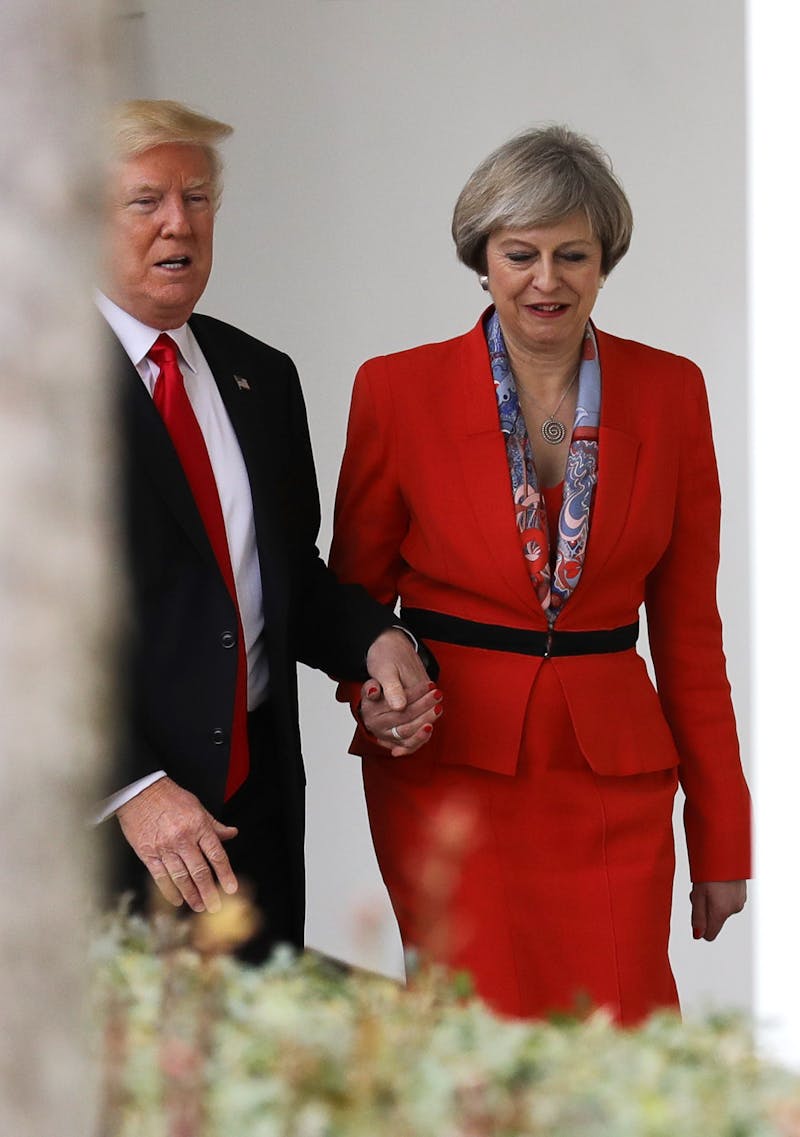George Washington suffered from a terrible fear of being buried alive, according to the Wikipedia entry on taphophobia (from the Greek τάφος, meaning “grave”). This diagnosis seems based on instructions he gave on his deathbed. Washington asked his attendants not to bury him until he had been dead for a couple of days. As one biographer points out, though, his request was not so strange. People were buried alive not so infrequently back then. Besides, in the grips of acute laryngitis, he was essentially dying of suffocation. Perhaps the sensation simply put him in mind of coffins.
This weekend, the press went berserk over the news that President Donald Trump supposedly gripped British Prime Minister Theresa May’s hand on a White House path as a result of bathmophobia, a pathological fear of stairs or inclines. The handclasp did not last long. As The Telegraph reported, “Just as the couple reach the top of the slope, the president stretches out his left arm and grabs at Mrs. May’s right hand. They then walk for about five steps before Mr. Trump slides his left arm across and pats the underside of Mrs. May’s hand, possibly grateful for her steadying presence.” The Sun was more dramatic: “‘SCARE’CASE: Is Donald Trump afraid of stairs and what is bathmophobia? Here’s all you need to know.” The condition, The Sun reported, is “common in household pets.”
In the psychological literature, however, bathmophobia doesn’t seem to exist. The Wikipedia entry on bathmophobia was deleted last year. A search in the scholarly literature only points to books like A Lexicon of Lunacy, or to results relating to bathophobia, the fear of pressurization (much more frightening). Amusing though it may be to think of Trump quaking in fear over ramps, and credible though reports have been of his reluctance to countenance stairs, it seems highly unlikely that bathmophobia is behind it all.
Famous people’s fears make great clickbait, it seems. One recent headline, optimized for search, went like this: “Kendall Jenner Trypophobia Adele Seagulls Celeb Phobias.” Sarah Michelle Gellar is terrified of graveyards. Pamela Anderson can’t stand mirrors. Billy Bob Thornton fears antique furniture. Also, bold colors. The media salivates over this kind of information because the readership loves junk psychology. Like idiotic diets and self-help books and aspirational lifestyle blogs, junk psychology commodifies and sells the most banal corners of our own minds back to us.

But coverage of the phobias of the powerful is different. There’s something exceptionally titillating about a powerful man who is terrified of something harmless. For example, Julius Caesar—a man who feared nothing—feared cats. Richard Nixon was terrified of hospitals.
Celebrity phobias symbolize cracks in their façade, proof that the rich and beautiful have simple terrors. But pathological fear in the hearts of the super-powerful does more than just humanize them. If we simply wanted Trump and Nixon and Caesar and Washington to be flawed and thus relatable, we could think of their loves and worries. But talking about their phobias represents something different: We want the statesmen who dominate us to be terrorized by fears whose size reflects their grandiosity.
Literary works like Boccaccio’s De casibus virorum illustrium (“the fates of great men”) explore our lust for stories about the big man brought low. The medieval Arthurian tradition has the king experience a vision of the wheel of fortune, in which a capricious figure brings men high and low according to her spins. In that dream, Arthur sees Alexander and eight other great men of history crushed by the wheel. In Hamlet, Shakespeare draws upon this tradition when he cites the “slings and arrows of outrageous fortune.”
The tabloids’ glee over Trump’s alleged bathmophobia fulfills a number of cultural functions. It makes a rich man seem silly. It satisfies the readership’s hunger for trash psychology. But it also makes a very powerful man seem, like Hamlet, cartoonishly flawed. In the story of Trump, we the audience seek his “ἁμαρτία,” his Hamartia. This is the fatal flaw that will ensure the hero of the tragedy comes to a sticky end. That way, this will all have been a diverting fantasy: Trump’s weakness will be his undoing and show him to be an Oedipus, a Phèdre. All plays end, and we will leave the theater. Catharsis will cleanse our nation, as the dawn will end the nightmare.
In these surreal first few days of Trump’s supremacy, we should hang on to reality. Diagnosing Trump with an unlikely phobia lets him off the hook for his bizarrely proprietary attitude towards Theresa May. It’s not normal to grasp a politician’s hand as you walk down a slight ramp. It’s more likely that Trump does not go up stairs in the White House because he’s spectacularly lazy, and he grabs women at random without thinking much about it.
Speculating about absurd terrors inside Trump’s mind makes him seem like a madman and our world like a stage. It makes the administration we live under into a carnivalesque dream. The more we bow to the rules that have governed our cultural fantasies—Aristotelian tragedy, medieval parable, fake science—the less we confront the current regime as it really is.
